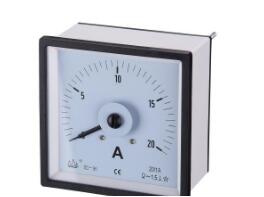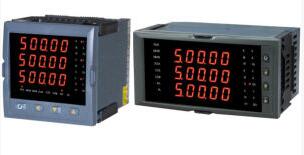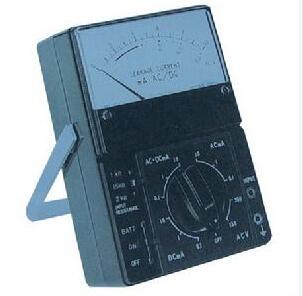The ammeter is an electrical instrument for measuring the magnitude and direction of the current, and is divided into a direct current ammeter and an alternating current ammeter. The commonly used ammeter is a magnetoelectric ammeter, whose main component is a permanent magnet and a movable coil. When the current being measured flows through the coil, it will be deflected by the moment of the magnetic field. The magnitude of the current of the ammeter is reflected by the angle of deflection and can be read by the position of the pointer fixed on the coil on the dial. Since the deflection angle is proportional to the current, the scale on the dial is uniform. When the measured current exceeds the range of the ammeter, the deflection of the pointer will exceed the limit of the scale. Not only can the current value be read, but also the pointer will be bent. When the current is too large, the coil will be burnt due to excessive Joule heat. Broken. Therefore, the range that each meter can measure has a certain limit, which is the range of the meter (or full scale current). Due to the different measurement needs, the ammeter is divided into three types: ammeter, milliampere and microampere. In the measurement of the induction cooker, an ammeter is usually used. The DC ammeter is an instrument used to measure the current in a DC circuit. Its header structure is magnetoelectric. The main parameters are: 1 range, that is, full scale current value; 2 internal resistance, usually the internal resistance of the DC current meter is very small, to reduce the voltage drop on the ammeter; 3 accuracy level, the accuracy level of the DC ammeter is divided into 0.1, There are 7 levels of 0.2, 0.5, 1.0, 1.5, 2.5, and 5.0. The smaller the level, the higher the accuracy of the ammeter. There are many types of AC ammeters, such as electromagnetic (moving iron), magnetoelectric, electric, digital, etc. The common shapes are shown in the figure. Figure AC ammeter shape The principle of the electromagnetic meter head is: when a current is passed through the coil, the energized coil generates a magnetic field, and a magnetic force is applied to the iron piece to force the rotating shaft to drive the balance spring to rotate. When the reacting moment generated by the balance spring is balanced with the attraction torque of the magnetic field to the iron piece, the pointer indicates the value of the current. Since the coil is energized to attract the iron piece, the angle at which the pointer is deflected is proportional to the square of the current flowing into the coil, so the scale is not uniform. In addition, since the direction of energization in the coil does not affect the direction of the pointer deflection, it can be used for both AC and DC. An ammeter is a measurement tool. It is only used in the measurement, so it should not be summarized in the inside of the appliance. If it is a current meter connected in series (such as the circuit of the motor), it is just a measuring tool (I just understand it). Then, from another angle, if the ammeter is connected in series with the motor (or other electrical appliances) and the measurement data is displayed during the work, then the power is consumed (although it is weak: but it also consumes power, otherwise the pointer Or the number can't be displayed). If it is said that since it consumes electricity, it should be an electrical appliance. This is to understand that it is an electrical appliance (the above explanation is only an ammeter that is connected to the line for a long time). Another example is the commonly used clamp meter, which is only a temporary measurement in the line. In this state, the ammeter can only be understood as a measuring tool. This can only be seen from what point of view. My understanding is that the ammeter is still a measurement tool. Not using electrical appliances. The ammeter, also known as the "ampere meter", is an electrical meter that measures the current in the circuit. The ammeter can be divided into three categories: AC current meter, DC current meter and AC/DC energy meter. These three types of ammeters are used in series with the circuit to be measured in electrical equipment and circuits, as shown in Figure 5.1. Figure 5.1 Current meter measurement basic circuit (1) The DC current meter mainly uses a measuring mechanism of a magnetoelectric electric meter. Generally, the current in the order of microamperes or milliamps can be directly measured. To measure a larger current, the ammeter should have a parallel resistor (also called a shunt). (2) The AC current meter mainly uses electromagnetic meter, electric meter and rectifying meter. The minimum range of the electromagnetic measuring mechanism is about several tens of milliamperes. To increase the range, the number of turns of the coil is reduced proportionally and the wire is thickened. When the ammeter is constructed by an electric measuring mechanism, the moving coil is connected in parallel with the stationary coil, and the minimum range is about several tens of milliamperes. In order to increase the range, to reduce the number of turns, and to thicken the wire, or to change the two static coils from series to parallel, the range of the ammeter will be doubled. When using a rectified meter to measure AC current, the ammeter reading is correct only when the AC is sinusoidal. A shunt can also be used to expand the range. In addition, a high-frequency current can be measured by a pyroelectric meter measuring mechanism. The large-range AC ammeter used in the power system is mostly an electromagnetic ammeter of 5A or 1A, and is equipped with a current transformer of appropriate current ratio. (3) The AC and DC ammeter can measure both DC current and AC current. According to the rated current, the ammeter is more than 1/3 or 1/2, which is mainly considered when the current at the cold start of the load is too large and the load is slightly overloaded. How to choose a current meter reasonably, according to the accuracy requirements of the measurement, reasonably select the accuracy of the ammeter, the pre-measurement check of the ammeter, the connection with the circuit under test, the correct reading, and the maintenance method of the ammeter. 1, reasonable selection of ammeter 1) According to the accuracy requirements of the measurement, the accuracy of the ammeter is reasonably selected. Generally speaking, the 0.1-0.2 magnetoelectric ammeter is suitable for standard meter and precision measurement; the 0.5-1.5 magnetoelectric ammeter is suitable for measurement in the laboratory; the 1.0-5.0 magnetoelectric instrument is suitable for use. Used as an electrical equipment operation monitoring and electrical equipment maintenance in industrial and mining enterprises. 2) Select the current meter of the corresponding limit according to the magnitude of the side current. If the limit is too large, the measurement accuracy will decrease, and if the limit is too small, the ammeter will be damaged. In order to make full use of the accuracy of the meter, the meter's range should be selected according to the principle of using the last quarter of the scale. 3) Reasonably select the internal resistance of the ammeter. The current resistance of the ammeter is required to be as small as possible. 2. Check of the ammeter before measurement Before measuring, check that the ammeter pointer is aligned with the “0†scale. If not aligned, adjust the “zero adjuster†to zero the pointer. 3. Connection of the ammeter to the circuit under test 1) When measuring, connect the ammeter to the low potential side of the circuit under test. 2) When measuring DC, you need to pay attention to the symbol of the end of the ammeter. For a single limit current meter, the current to be measured should flow from the end of the current meter marked with “+â€, and the current meter from the end button marked “—â€; The current limit meter, marked with "*" is the common button, if the other button is marked with the "+" symbol. The current to be measured should flow from the "+" terminal and flow out from the "*" terminal; if the other terminal is marked with the "-" symbol, the connection is exactly the opposite of the above. 4, the correct reading of the ammeter When reading, keep the pointer steady before reading, and keep the line of sight perpendicular to the dial. If the dial has a mirror, the pointer and the pointer should be coincident in the mirror to reduce the error. 5, the maintenance method of the ammeter 1) Since the overload capability of the magnetoelectric ammeter is very small, the polarity and the limit of the connection circuit must be selected when using. 2) If the reverse deflection or forward deflection of the pointer is found in the measurement and exceeds the full scale line on the scale, the measurement should be stopped immediately after the power is turned off, and the current meter should be connected or re-selected for a larger number of current meters before measurement. 3) When the measurement is completed, the power should be disconnected, and then the ammeter should be removed from the measuring circuit and placed in a dry, ventilated and cool environment. For micro-ampere meters and milliampere meters with high sensitivity and accuracy, the wires are used to connect the positive and negative terminals to protect the measuring mechanism of the meter. Remote Control Panel,Magnum Remote Panel,Remote Screen Panel,Magnum Energy Inverter Control Panel SUZHOU DEVELPOWER ENERGY EQUIPMENT CO.,LTD , https://www.fisoph-power.com




The ammeter is not using electrical appliances _ ammeter is what to do _ how to choose ammeter
What is an ammeter?